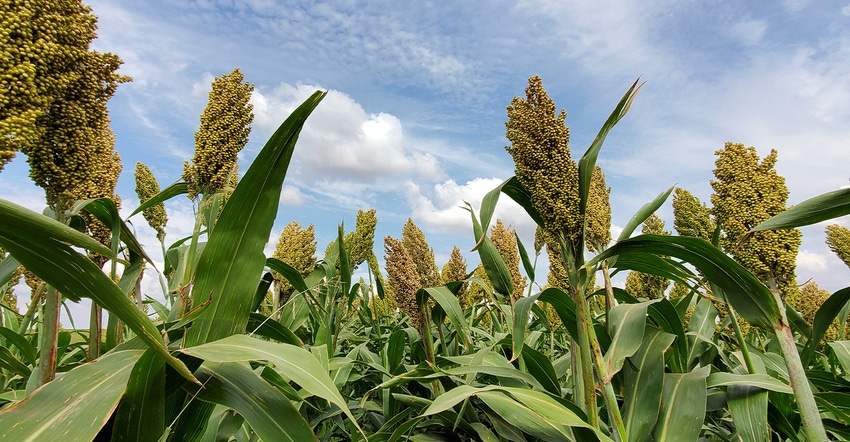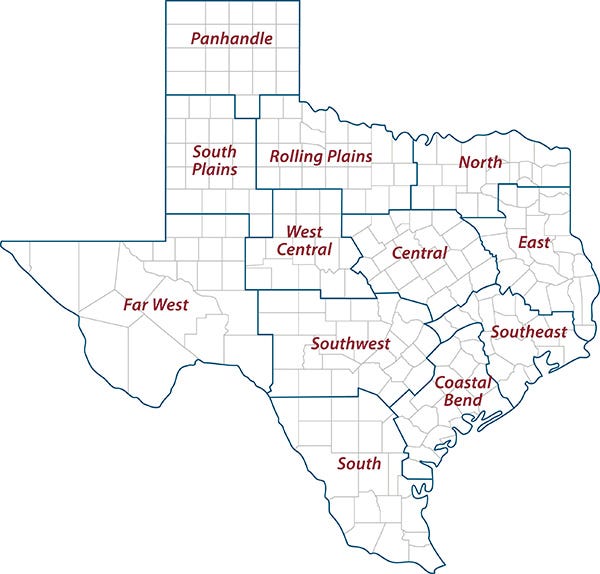
Sorghum acres are expected to be up this year as prices and increased export demand have made the crop a hot commodity, according to a Texas A&M AgriLife Extension Service expert.
Ronnie Schnell, AgriLife Extension agronomist, Bryan-College Station, said sorghum producers could be in for a good year with timely rains.
About half of the state’s sorghum is planted at this point, Schnell said. Plantings in the Rio Grande Valley were at boot stage if not flowering already and areas along the Gulf Coast and Central Texas were progressing well.
See, Drought challenges PRE, POST weed treatments
A few acres in the Rio Grande Valley were affected by the February winter storm, but weather conditions are allowing planting to remain on schedule for the rest of the state and provide good stands, he said.
The U.S. Department of Agriculture reported the final tally of sorghum acres in 2020 was 1.8 million acres, and Schnell expects increased acreage this year due to good prices.
“I wouldn’t be surprised if we were over 2 million acres of sorghum this year,” he said. “Prices have been better than corn in some areas, and now producers need favorable weather to capitalize on those prices.”
Sorghum off to good start
With good market conditions in place, weather will continue to be the question mark for much of the state, Schnell said. Sorghum tolerates heat and drier conditions better than other row crops, but water is necessary to produce good yields.
Most of the areas north of South Texas from the Upper Gulf Coast throughout the Blacklands have relatively good subsoil moisture indexes, but the soil surface is drying quickly. Areas still yet to plant sorghum, including the High Plains, are reporting short to very short soil moisture levels.
See, Agronomist addresses preplant sorghum herbicides
Schnell said storm systems delivered scattered rainfall recently, but the variation between the haves and have-nots was notable.
“Fields are off to a good start from the Valley to North Central Texas, but we need rain to keep fields progressing well,” he said. “The majority of the state is under some level of drought condition, and while scattered rains have helped some, we need more rain-making systems to move through the state and cover a broader area.”

Few issues beyond drought
Schnell said there have been very few problems with sorghum so far this growing season. Rains would help producers who have or will be making fertilizer applications soon, and dry conditions may make herbicide activation inconsistent, but disease and pest infestations have been light in South and Central Texas.
See, COTTON SPIN: Cotton picture remains tight
Seed companies have produced several sugarcane aphid-tolerant varieties that have helped curb their impact on sorghum yields, Schnell said. Monitoring the pests numbers and acting on good science-based recommendations to address infestations has also helped reduce their impact.
This year, herbicide-tolerant sorghum hybrids have been introduced to limited acres with more becoming commercially available soon, he said. Farmers will be able to broadcast apply herbicides over the top of sorghum for post-emerge grass control.
“All these hybrids were produced using traditional breeding methods and are non-GMO,” he said. “They’re just another set of tools farmers can use to manage weeds and protect yields.”
AgriLife Extension district reporters compiled the following summaries:

CENTRAL
Some rainfall and hail were reported. The precipitation helped topsoil moisture conditions, but subsoil moisture remained poor. High temperatures and crop water demand were expected to dry the soil surface very rapidly. Light frost was reported, and producers were not sure what it may have done to fruit and pecan trees. In some areas, the frost killed back Bermuda grass that was trying to grow. Livestock were in fair condition with some supplemental feeding. Pastures were greening up. Fertilizer wagons were busy before the rain. Small grains looked good, and all fields were headed out. Some producers were preparing to plant summer annuals for hay soon. Stock tanks continued to dwindle. Corn and sorghum were progressing well, but some fields were being replanted due to dry topsoil conditions. Some growers reported poor establishment of spring-sprigged Bermuda grass, due to the lack of spring rainfalls and competition from annual weeds. Winter wheat was at filling stage and needed rainfall. Some of the earliest planted wheat was already starting to turn color, but most fields were near the end of flowering stage.
ROLLING PLAINS
A few storms moved through part of the district bringing hail and a brief heavy rain. Most wheat fields were headed and looked fair to good. The possibility of near-freezing temperatures had producers’ eyes on wheat conditions and any signs of damage. Some producers were spraying for rust in wheat.
COASTAL BEND
Light showers fell in some areas, but most of the area was still very dry. All crops needed a soaking rain. Corn in light soils was starting to suffer. Cotton replanting continued in some fields, mostly due to poor emergence in a few varieties. Conditions were also windy, which hampered herbicide applications on hay fields and pastures. Cutting and baling of oats and ryegrass was moderately active. Rangeland and pasture conditions continued to decline, and more producers were becoming short on available forage. Livestock were doing well overall. There were larger calf volumes at sale barns. Prices on cull cows and bulls were steady with good prices. Some pecan orchards reported larger catkin crops but will need moisture for the potential crop to make.
EAST
Recent rains helped growing conditions in many areas. Jasper County reported flooding that damaged crops and left standing water in pastures. Cooler night temperatures continued to hinder growth of warm-season forages. Pasture and rangeland conditions were fair to good. Subsoil and topsoil conditions were adequate. Corn and watermelon crops were doing well. Tomatoes were being planted. Timber production seemed to be harvesting lots of pulp wood and saw logs of both hardwood and pine. Livestock were doing fair to good. Some producers continued to feed hay and cubes. Horn flies were out in large numbers. Feral hog activity increased.
SOUTH PLAINS
Farmers continued to prepare for spring planting and were busy spraying and plowing. Two nights of freezing temperatures overnight were reported. The district needed more moisture for spring planting to be successful. Record drought continues from last year, and most of the district does not have enough subsoil moisture for a successful planting season. Cattle were grazing wheat and available grasses.
PANHANDLE
Northern parts of the district reported short to adequate topsoil and very short to adequate subsoil moisture. Soil moisture levels in central areas were short, and short to very short in southern areas. Pasture and rangeland conditions were very poor to fair. Winter wheat was in poor to fair condition and needed moisture to progress. Multiple freezes were reported and likely damaged wheat. Producers continued preparing fields and were waiting for rain. Corn planting was right around the corner.
NORTH
Topsoil moisture was adequate. Cooler temperatures delayed the growth of pasture grasses, but warmer temperatures forecasted should help rye grass growth. Corn and wheat were also projected to see a jump in growth as well. Cooler temperatures also delayed plantings of cotton, soybeans and grain sorghum.
FAR WEST
Temperature highs averaged in the mid-90s with nighttime lows in the mid-30s. Precipitation was reported but there were no measurable totals. A fire burning in Big Bend National Park in southern Brewster County had burned over 1,350 acres, but was over 80% contained. Extreme drought conditions continued across the district with livestock producers drastically reducing herd sizes due to rangeland conditions. Pecan producers were beginning to water their trees. Beef cattle were still in overall good condition. Very cool temperatures slowed corn and watermelon crops with mostly no growth at all reported. Warmer and much windier conditions returned for the second half of the reporting period and continued to dry out soils. Producers tried to pre-water fields for cotton, but irrigated acres were being reduced to put more water on fewer acres. Some growers were considering turning wells off instead of fighting the drought. Working the soil was very difficult as the ground was basically powder, and high winds continued to create dust storms. Pecans continued to put on new growth for the upcoming season. Irrigated wheat was being baled for hay. Dryland sorghum had still not emerged. Pastures had no grass, very few weeds and many operations did not have any livestock. Ranchers were considering not putting any cattle onto their pastures this year in hopes of some grass growth.
WEST CENTRAL
No report.
SOUTHEAST
Parts of the district received cooler temperatures and significant rain, up to 4 inches. The rain helped rice emerge. Other areas did not receive enough rain for pastures, and some rice was very uneven due to the inconsistent moisture. Rangeland and pasture ratings were fair to very poor with fair and good ratings being common. Soil moisture levels ranged from adequate to very short with adequate being the most common.
SOUTHWEST
Dry weather continued across the district. Some trace amounts of rainfall were reported and were followed by a cold front. Pasture conditions and dryland crops were still struggling due to the lack of moisture. Wheat fields looked good and were close to harvest. Oat fields were about gone due to grazing. Rangeland conditions continued to be fair. Corn, milo, hay grazer and improved pastures needed rain. Rain was in the forecast. Spring shearing was underway, and livestock were in fair condition. Supplemental feeding of livestock continued, and some producers were considering destocking.
SOUTH
Soil moisture levels were short to very short throughout most of the district. Conditions were hot and dry, though some parts of the district received rainfall. Northern parts of Live Oak County reported 0.5-1.5 inches and Jim Wells County reported up to 1 inch of rainfall. Zapata County reported trace amounts up to 1.5 inches of scattered rainfall. Southern parts of Starr County reported 3 inches of rainfall. Frio County reported cooler weather. Rainfall was in the forecast. Most crops were under irrigation. Some cotton was planted, and planted cotton was struggling to emerge in drier areas and being cultivated and fertilized in other areas. Some cotton fields had reached first square stage, while other fields were being replanted due to dry conditions. Some sorghum was planted but was not expected to germinate without irrigation or rain. Corn and grain sorghum were 90% emerged. Pasture and rangeland conditions were poor to very poor, and supplemental feeding continued. Prickly pear cactus was blooming and producing fruit for cattle and wildlife. Cattle prices continued to fall as producers continued to cull cows and wean calves early. Hay bales were $100 and becoming scarce. Body condition scores in cattle were starting to decline. Stock tanks were becoming dry. Webb County reported green pastures and that stock tank levels were up. Irrigated vegetable crops were in good condition, and Bermuda grass fields were nearing their first cutting. Hay producers were fertilizing fields. Sesame was planted. Onions were still being harvested. There was very little insect pressure on crops. Some citrus trees looked to be recovering, and some growers pruned back dead wood, but many trees still looked to be in bad shape due to Winter Storm Uri.
Source: is AgriLife TODAY, which is solely responsible for the information provided and is wholly owned by the source. Informa Business Media and all its subsidiaries are not responsible for any of the content contained in this information asset.
About the Author(s)
You May Also Like




